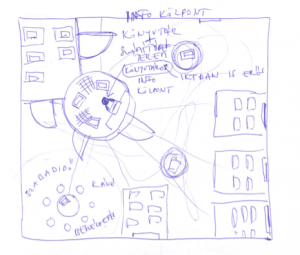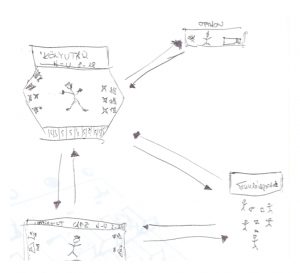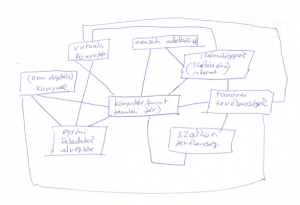Date and Time: 22.02.2011, 15.00 – 17.15
Participants: Three secondary school teachers: Kriszta, English/ICT teacher; Géza, science/biology/geography teacher; Tímea, English/Russian teacher.
Researchers / Designers: Attila, Gabriella, Ildikó
Scenarios discussed: Library as learning space, Reacting to student feedback
Library as learning space
The general impression of the teachers was that the scenario was unrealistic on the whole, although most of the details in themselves could be realised happen after some modification in average Hungarian schools.
Issues regarding actions
Géza’s opinion was that the student in the scenario was unrealistically self-sufficient and motivated. All the three teachers expressed their doubts about students spending so much of their free time in the school library instead of going home and accessing the VLE or other systems from there, or using a smart phone if they have one.
Students will first ask Google, not the librarian.
According to Géza, Tímea and Krisztina’s experience, students rather spend their whole day at school, but they typically do not have activities at school late in the afternoon or in the evening. The participants could imagine the film making workshop as an activity which might be offered during the afternoon and once a week. The participants suggested that the film making workshop should be conducted by an expert (ICT or arts teacher) who might not be identical with the librarian. They said that it might be possible that the librarian was not present at all and the expert opened and closed the library.
Géza and Tímea said that the school library in their schools had very limited opening hours,and only during the day. Tímea even added that this scenario could not be realised in this form, in the school library. The participants suggested to make the afternoon lesson an online activity although Kriszta expressed her doubts about the effectiveness of working online compared to face-to-face meetings.
Krisztina said that it was not clear how the librarian and the history teacher worked together. Some kind of collaboration was a must for this scenario.
Géza said that project work in Hungarian schools was not yet typical, though forms of co-operation were fairly known and used. The three participants agreed that with reasonable alterations this part of the scenario could be realised.
All the three participants said that it was not typical that students took part in group learning sessions that involve students of different ages, working on cross-curricular projects.
The participant teachers became anxious about how they could conduct a film making workshop.
ssues regarding infrastructure and tools
Géza and Krisztina said that they had an LMS intheir school, but Tímea’s school had no one, and their common opinion was that it was not typical in Hungarian schools. They said it depended on the school management. Tímea said there was no possibility to reach the school library system from outside the library eitherl. In Krisztina’s opinion individual teachers used online applications, such as grou.ps, ning, edmodo, and students accessed them typically from home. In this scenario, as they said, these tools should be used instead of LMS-s, since they had document sharing and networking functions.
All participants expressed their doubts whether the librarians had the professional skills to provide sufficient help or whether the librarian had enough time to help each individual learner. The participants agreed that it might be the case in some schools but could imagine this sort of service more in higher education than in a secondary school.
The online National Audiovisual Archive (NAVA http://www.nava.hu/) is available in a great number of libraries. This archive can be used for educational purposes only, so the learner can not access them from home, only from the so called NAVA points. School libraries are very likely to be NAVA points. Anyhow, it is not allowed to download or to share these films because of copyright issues.
Some ideas came up concerning the design of the library as a learning space. The library should be at least as big as a classroom and should have a relatively separated work area with easy-to-move chairs, where people are allowed to discuss and drink tea not disturbing others. Several smaller separate rooms may be attached to the library..
Kriszta and Tímea agreed that the library could be used as a virtual learning space if a little bit more (more than it is typical in Hungary) computer stations were present and the librarian were qualified to provide sufficient help.
Reacting to student feedback
All participating teachers agreed that this scenario was easier to implement than the previous one.
Issues regarding actions
The participants welcomed the idea that the teacher got regular feedback from his students with the help of the response system and than planned the differentiation according to the results.
Tímea didn’t like the idea that specific resources were linked automatically to the ‘graduated lesson plan’, she would prefer to delegate the resources and tasks herself when she thought it was appropriate. The participants saw a great potential in peer tutoring and also in learning from other students’ works.
The teachers could imagine the scenario in a time frame longer than a single 45min. lesson. They suggested that a detailed evaluation should take place outside the classroom during the teacher’s preparation for the next lesson, but some questions might help during the class to make ad-hoc decisions.
Géza said that realising the scenario demanded a great deal of concentration from the teacher not just for managing the digital tools, but also to make the right decisions in order to differentiate.
Issues regarding infrastructure and tools
The participants agreed that both LMS-s and Learner’s Response Systems were rare but the latter were easier to access since a set might be borrowed locally.
The participants and the researchers did not know about any system that merged data from LMS and Response System.
It is probable that a classroom management system is also needed in this scenario.
The teachers collected ideas about how the LMS could be substituted. They agreed that if it was not necessary to see both assessment data and Response System data on the same surface, than virtual classrooms, google docs or even e-mails could replace LMS when delegating resources and tasks. The participants expressed their concerns about the insufficient amount of digital learning materials. Tímea suggested that digital and non-digital materials should be mixed. Tímea imagined that the graduated lesson plan was filled up by the teacher with his or her own collected materials. Attila suggested that the graduated lesson plan can be as simple as a collection of links.
Tímea asked how we should understand app store, if it was a collection of teaching contents offered to them, or if it was a result of individual searching activities led through a period of time.
Krisztina and Tímea asked if app store comprised only digital contents or any kind of teaching resources.










